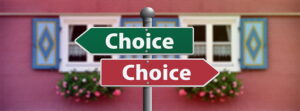
In neuromarketing, understanding the art of comparison is non-negotiable. The dichotomy ranges from pleasure to pain, comfort to discomfort, and every conceivable contrast in between. The internal dialogue of a prospective customer is incessantly buzzing with comparisons: “Will this product elevate my status?” “Can it enhance my wellbeing?” “Will it accord me greater respect?”
While these thoughts might hover below the conscious threshold, their presence and influence are perpetual. In this exploration of Neuromarketing, we will look into the potency of comparison to nudge people towards making a purchase.
Before we can leverage this to our advantage, a foundational understanding of comparison psychology and its sales-boosting potential is indispensable. Subsequently, we will unravel how the physical and perceived size of products can be tactically utilized.
The Paralysis of Choice
Why isn’t your product flying off the shelves? The culprit is often the overwhelming plethora of choices confronting the consumer, leading to decision paralysis and ultimately, inaction. This dilemma can largely be attributed to the saturated marketplace. To navigate this, initiate the process of elimination. Eschew the disparagement of competitors; instead, subtly cast doubt on the discernment of their clientele. No one desires to be perceived unfavorably, and this apprehension can deter potential customers from associations that might tarnish their image.
The Unconscious Decision Maker
Consumers weigh their options and then commit. Neuromarketing shines by simplifying this decision-making process. Capitalizing on the largely unconscious nature of decision-making is your golden ticket. Accelerating the journey from contemplation to purchase hinges on the swift resolution of this process. How? Through strategic questioning. Loaded questions prime the brain, easing the path of influence. What queries could you pose to guide this journey?
Employing the Decoy Strategy
The decoy strategy emerges as a masterstroke for hastening consumer choice and purchase. This involves introducing an option designed to make other choices more appealing by comparison. Fast-food giants exploit this by offering “extreme” sizes, thereby nudging customers towards slightly smaller (yet still large) choices by establishing a new, exaggerated benchmark.
Practical Application: The Power of Three
A practical manifestation of this strategy involves grouping your offerings into three tiers, especially when aiming to phase out a particular item. By pricing the less desirable product comparably to the lowest-priced option or positioning it in the middle, and showcasing the most expensive option first, you establish a psychological anchor. This makes the target product more appealing, either by virtue of its perceived value or its middle-ground pricing.
Case Study: A Taste of Strategy
During my stay in Nicaragua, I collaborated with Tom, an Irish expat and pub owner in Granada, facing a dilemma with a sluggish menu item. Employing the decoy strategy, we revitalized his menu, which not only cleared his inventory but significantly boosted overall sales.
Cataloging Success
In a broader retail or restaurant context, dedicating a space—such as a separate page or menu section—for your top sellers can streamline the decision-making process for your customers. This curated presentation acts as a guide, narrowing down choices and enhancing the customer experience.
The Imperative of Adaptation
In today’s hyper-competitive landscape, complacency is the harbinger of obsolescence. Leveraging every tool at your disposal to stay ahead is not just advisable—it’s essential. By engaging with this blog, you’re demonstrating a proactive stance towards mastering neuromarketing strategies to not just survive, but thrive.